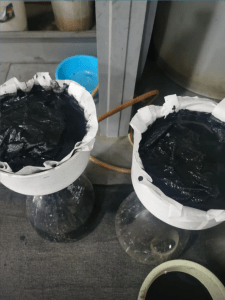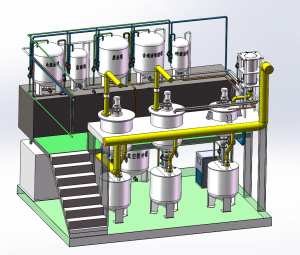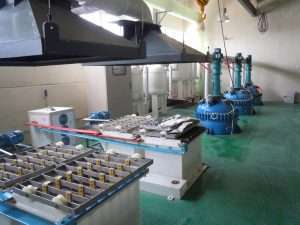Call us now:
What are the electrolytic silver process
Silver electrolyte purification and residual electrode treatment:
1. Electrolyte purification process: By adding silver oxide to the waste electrolyte and adjusting the pH of the electrolyte, all impurities such as bismuth, antimony, lead, copper, and iron in the electrolyte can be precipitated. The purified silver electrolyte can be returned to electrolysis after adding nitric acid to adjust the acidity.
2. Silver electrolysis anode slime treatment: add nitric acid to the cleaned anode slime, and other metals in the anode slime except gold can be dissolved in nitric acid, and nitric acid is used to dissolve the anode slime. The dissolved solution is added with a reducing agent to reduce silver, and the insoluble residue is sent to the gold recovery process.
3. Electrolytic residual electrode treatment: the residual electrode rate of silver electrolysis is about 10%. After the electrolysis is completed, the residual electrode is manually taken out, put into the transport vehicle and transferred to the silver electrolysis unit without residual electrode to continue electrolysis; after washing and drying The silver powder is sent to the ingot casting and marking process, and then put into storage after completion;
The things needed are as follows
Anode plate
The raw material for silver electrolytic purification is various impure metallic silver, which is cast into a rough silver anode plate. It is required that the copper content in the rough silver anode plate is less than 5%, the total amount of gold and silver is more than 95%, and the gold content is not more than gold. 1/3 of the total amount of silver. If the gold content is too high, coarse silver must be added to avoid anode passivation. Coarse silver anode plates must be placed in a diaphragm bag to prevent anode slime and residual poles from falling into the bottom of the electrolytic cell and contaminating the electrolytic silver powder.
The cathode plate of silver electrolytic purification is preferably a pure silver plate, and a stainless steel plate or an iridium plate can also be used. The electrolytic silver is precipitated at the cathode in granular form and is easy to scrape off. The scraped silver particles sink directly to the bottom of the tank, and the cathode can be used for a long time.
Electrolyte
Silver nitrate electrolyte is used at home and abroad for electrolytic purification of silver. The electrolyte composition is usually: Ag30-150g/L, HNO, 2-15g/L, Cu40g/L. When preparing the electrolyte, moisten the electrolytic silver powder containing 99.86%~99.88% silver with water in acid-resistant porcelain red, then add nitric acid and water in stages, and dissolve under self-heating conditions. The liquid-making process takes 4~4.5h, and the solution contains Silver 600~700g/L, nitric acid less than 50g/L, and then diluted with water to the required concentration as electrolyte for later use. Or directly add the concentrated silver nitrate solution to the electrolytic cell according to the calculated amount. The liquid-making operation must be carried out in a fume hood, which produces a large amount of nitrogen oxide gas, which can only be emptied after washing and absorption. A factory in my country uses 8013 catalyst to treat nitrogen oxide tail gas with ammonia water, and the effect is good, with an absorption rate of over 99%.
Some factories use silver powder or coarse silver alloy plates with low silver content and various impure silver raw materials to prepare silver nitrate electrolyte. Japan uses an electrolyte containing 40~50g/L of silver. Electrolyte containing 50~100g/L of silver is often used in my country.
The nitric acid in the electrolyte is to improve the conductivity of the electrolyte, but the nitric acid content should not be too high, otherwise the precipitated silver will be reversed, NO2 gas and hydrogen will be separated out.
The concentration of silver ions in the electrolyte depends on the current density and the silver content of the coarse silver anode. The current density is high, and the concentration of silver ions should be high, so as to ensure a higher concentration of silver ions in the cathode area. The silver content of the coarse silver anode is low and there are many impurities, so the concentration of silver ions in the electrolyte should be higher to inhibit the precipitation of impurity ions at the cathode.
Electrolyzer
For the electrolytic purification of silver, Miaobius vertical electrode electrolyzers are widely used at home and abroad, mostly reinforced concrete tanks, lined with soft plastic, and the tank shape is nearly square, and hard plastic tanks can also be used.
In order to overcome the difficulty of manual electrolytic silver powder, a factory connected the lower part of a row of electrolytic cells in series, and installed a polyester cloth endless conveyor belt at the bottom of the tank, and continuously sent the electrolytic silver powder falling on the belt to the stainless steel outside the tank as the conveyor belt rotated. in the slot.
At present, vertical electrode electrolyzers welded with hard polyvinyl chloride plates are mainly used in China. The tank is horizontally divided into several small tanks by partitions not connected to the bottom of the tank, and the bottom of the small tanks is connected, and the electrolyte can circulate. The connected part of the bottom of the tank is equipped with a polyester cloth non-polar conveyor belt, which is specially used for transporting the silver powder in the tank. A mechanical stirring device with a glass rod (or rigid polyvinyl chloride rod) is installed on the surface of the tank, which can be started regularly to prevent the short circuit of the cathode and anode, and to stir the electrolyte.


